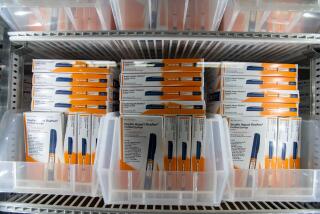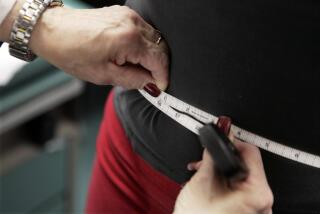Is the medicine you depend on made in a place you trust?
Any product that endangers consumers is a bad one. But there’s a difference between something you buy because you want to and something you buy because you have to.
That’s what makes the current scare about Chinese-made medicine so troubling.
Batches of the blood thinner heparin were recalled worldwide last week, after at least 19 deaths and hundreds of allergic reactions were reported in the United States. The drug is commonly used to prevent clots in patients with heart trouble or during surgery.
The Food and Drug Administration found that some heparin ingredients produced in a Chinese factory had been contaminated with a man-made chemical called oversulfated chondroitin sulfate. The substance mimics the blood-thinning actions of heparin but is cheaper to produce.
It’s still unclear how the chemical got into the heparin batches, but investigators aren’t ruling out the possibility that a Chinese supplier tried to boost its profit by substituting the cheaper chemical for real heparin ingredients.
When parents hear that a certain toy has lead in its paint, they can choose not to buy it. But people who rely on specific drugs to keep them well may not have that choice. Moreover, they may not know where their drugs were manufactured, making informed decisions all but impossible.
Incredibly, the FDA doesn’t require drug companies to disclose where prescription medicines come from. Companies are free to say as much, or as little, as they please.
The $650-billion global pharmaceutical industry clearly benefits by purchasing supplies and producing drugs in countries where costs are lower.
But all you know as a consumer is that someone in a white lab coat at the pharmacy has handed you a medication that you believe will make you better. The level of trust that surrounds this transaction is virtually unparalleled in the retail world.
Having been diagnosed with Type 1 diabetes in October, I reflect that trust every day. And I’m not alone.
About 21 million people have been diagnosed with diabetes nationwide and 246 million around the world. By 2020, the global total is expected to reach 380 million, the result of increasingly sedentary lifestyles and poor eating habits (or, as in my case, funky genes).
The glucose meter I use to test my blood sugar as often as a dozen times daily was distributed by LifeScan Inc. of Northern California, a division of Johnson & Johnson. But it was made in China -- where, exactly, I have no idea, or under what conditions.
The little strips that I insert into the glucose meter for each test come from Britain. The lancing device I use to prick my finger comes from China. The lancets are from Japan. The needles for my five daily insulin shots come from Ireland.
But what about the insulin, which I rely on to keep me alive? I use two types, a fast-acting form called NovoLog and a long-acting form called Levemir, both manufactured by Denmark’s Novo Nordisk, one of three leading producers.
In fact, that’s exactly what the packaging says: “Manufactured by Novo Nordisk A/S, DK-2880 Bagsvaerd, Denmark.” That’s the address of the company’s headquarters.
But does that mean the insulin actually comes from the land of Hamlet? Not exactly.
Producing insulin in laboratories is a two-step process. First, the insulin is created in crystal form, which is more easily handled and stored. Then it’s converted to liquid form in vials or pre-filled cartridges for delivery to users.
In the case of Eli Lilly & Co., insulin crystals are produced at the company’s Indianapolis headquarters or a plant in Puerto Rico. Vials containing liquid insulin are produced in Indianapolis, but cartridges for insulin “pens” or pumps may be produced either at headquarters or at a plant in France.
Packages specify whether the cartridges come from the United States or France. Users thus have no idea that their medication actually may have originated in Puerto Rico.
“Technically, that’s correct,” said Scott MacGregor, a Lilly spokesman. “But we make no secret that we have a large plant there.”
There may be nothing wrong with insulin crystals from Puerto Rico. But for anyone who has to use insulin multiple times daily, this isn’t a trivial piece of information.
Manufacturing prescription drugs accounts for a significant portion of Puerto Rico’s economy. However, some leading drug companies are closing plants on the island because of, among other reasons, ongoing issues with regulatory compliance.
A recent investigation by the Associated Press turned up “dozens of examples over four years of lapses in quality control in the Puerto Rican pharmaceutical industry.”
For its part, France’s Sanofi-Aventis says its insulin crystals and finished insulin are produced in Germany, which is cited in promotional materials as the “country of origin.”
A spokesman for Novo Nordisk, Sean Clements, said the company produces its insulin crystals in Denmark. Those crystals are then converted to liquid at various plants worldwide.
Clements said finished insulin for the U.S. market comes from FDA-registered plants in the United States, Denmark or France. He said FDA approval was pending for the company’s facility in Brazil, which is undergoing a $200-million expansion -- the biggest single investment ever in Brazil’s drug industry.
About 95% of the output of Novo Nordisk’s Brazilian plant will be exported around the world, the company said.
A 2000 study by the World Bank concluded that Brazil’s pharmaceutical industry suffered from “insufficient implementation and enforcement of drug regulations which can assure that quality standards are in place.”
“Evaluation, registration, surveillance, audits and inspections are not being carried out as they should,” the World Bank found, adding that “there is also a limited knowledge base among inspectors, which indicates their need for training.”
Novo Nordisk’s Clements said customers can be confident that the company maintains high quality standards throughout the world.
“Regardless of manufacturing site, our manufacturing sites and supply chain that supply our U.S. customers operate under FDA-approved and Novo Nordisk standards for high quality and safety,” he said.
Last week, California regulators said they’d delay by another two years a requirement that all prescription drugs be electronically tracked to help prevent contamination and counterfeiting. The system was originally slated to begin last year, but it was pushed back to January 2009 amid protests from drug companies.
Now it won’t begin until 2011 at the earliest.
A tracking system might have caught the tainted heparin before it reached hospitals and pharmacies, thus preventing 19 deaths. It seems outrageous that we’re still waiting for such an obvious safeguard to be put into place.
At the very least, consumers are entitled to know where their medications come from. The FDA should require all drug companies to clearly state on packages where a drug was manufactured or processed and the origins of its major components.
Karen Riley, an FDA spokeswoman, said this would be difficult.
“We have products that have active ingredients, inactive ingredients, that are finished, that are raw,” she said. “How would you do country of origin for all that?”
It doesn’t seem so hard. In the case of Eli Lilly’s insulin cartridges, you could simply state: “Manufactured in France from Puerto Rican components.” This would be accompanied by a Web address where more detailed info would be available.
Such a requirement would have the dual benefit of allowing consumers to make better decisions about the drugs they take as well as making drug companies more accountable for their global operations and suppliers.
It could also add value to a “Made in the USA” label. Would you pay a dollar or two more for that peace of mind? I might.
There’s no changing the worldwide nature of the drug industry. But with lives at stake every minute of every day, the onus is on drug companies to be completely transparent in their activities.
They aren’t even close.
--
Consumer Confidential runs Wednesdays and Sundays. Send your tips or feedback to david.lazarus@latimes.com.
--
(BEGIN TEXT OF INFOBOX)
The global reach of the drug industry
Prescription drugs and medical supplies are manufactured worldwide, but federal regulators don’t require country-of- origin labeling. David Lazarus learned that his diabetes gear was produced primarily in Europe and Asia, but he couldn’t find out for sure where his insulin came from.
Glucose meter: China
Lancets: Japan
Test strips: Britain
Lancing device: China
Needles: Ireland
Insulin: Denmark? (Maybe France,
maybe the U.S. And soon, maybe Brazil.)







